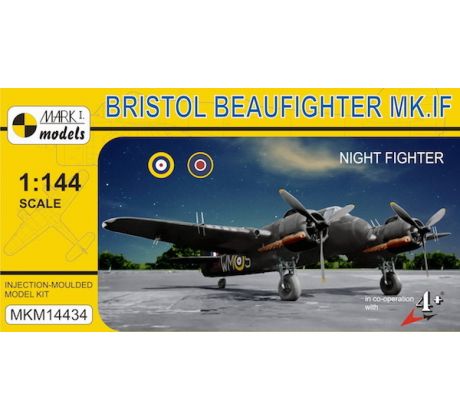Bristol Beaufighter Mk.IF 'Night Fighter'

Bristol Beaufighter Mk.IF 'Night Fighter'
This injection-moulded kit contains 53 parts and six clear parts (cockpit canopies, position lights etc.). A comprehensive instruction leaflet and a decal sheet are included.
Colour schemes included in the kit:
1) Bristol Beaufighter Mk.IF, R2248, Grey WM-S, No.68 Sq., RAF, High Ercall airfield (detachment Valley, Anglesey), autumn 1941
2) Bristol Beaufighter Mk.IF, X7671, Red WP-D, No.89 Sq., RAF, Abu Sueir airfield, Egypt, spring 1942
3) Bristol Beaufighter Mk.IF, T4637, Red NG-O, No.604 Sq., RAF, Middle Wallop airfield, autumn 1942
4) Bristol Beaufighter Mk.IF, V8318, Sky F, No.252 Sq., RAF, El Magrun (Al Maqrun) airfield, Libya, spring 194
| Ref. No.: | MKM144034 |
| Availability: | IN STOCK |
Bristol Beaufighter Mk.IF 'Night Fighter'
Bristol Beaufighter Mk.IF 'Night Fighter' The Bristol Beaufighter was a British long-range heavy fighter, developed early in 1939 from the Beaufort torpedo bomber. It became an efficient night-fighter, employing the then novel AI radar. Following short-term development the first prototype flew in July 1939 and the first aeroplanes reached the squadrons in the summer of the next year.
The Beaufighter was a two-seat, twin engine, all-metal mid-wing cantilever monoplane, fitted with a retractable undercarriage. It was powered by two Hercules radial engines and the armament consisted of four cannons in the nose, four guns in the starboard wing and another two guns in the port wing.
The Beaufighter Mk.IF was destined for RAF Fighter Command units, while the Mk.IC, fitted with an additional radio and navigational equipment, was a dedicated long-range fighter for the Coastal Command. Total production of both variants reached 914 aircraft.
The Beaufighter had a long career and served in almost all theatres of war during the WWII, at first as a night fighter, then as a fighter-bomber and eventually being used as a torpedo-bomber.





